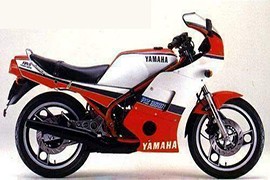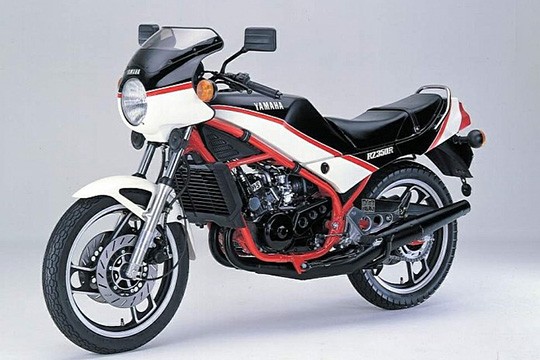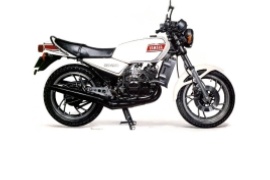YAMAHA RZ Models/Series Timeline, Specifications & Photos
First production year: 1980
The Yamaha RZ 350 was a motorcycle that debuted in 1983 to replace the Yamaha RD 350LC and continued production until 1995. The bike was available in the American market from 1983 to 1985, until 1990 in the Canadian market, and until 1996 in the Brazilian market.
The RZ model was the final evolution of the well-known RD series in Yamaha's range. The RZ 350 model was also known as the RD 350LC II or RD 350 YPVS (Yamaha Power Valve System).
In 1984, the Japanese motorcycle manufacturer launched the Yamaha RZ 350RR, a fully faired motorcycle with standard features, such as a rectangular headlight, a medium-sized windscreen, a one-piece dual seat with a passenger grab handle, a blacked-out exhaust system, and three-spoke lightweight aluminum wheels.
The motorcycle packed a 35 mm air-assisted telescopic fork on the front with 140 mm of travel and a five-way preload adjustable shock absorber on the rear with 100 mm of travel, delivering optimum suspension performance and handling.
The braking power was handled by two 260 mm discs coupled to dual-piston calipers on the front wheel and a 260 mm disc with a single-piston caliper handling the rear wheel, providing reliable stopping power.
As for the power figures, the 1984 Yamaha RZ 350RR had installed a 347cc two-stroke parallel-twin liquid-cooled engine underneath its full fairing, delivering 59 hp at 9,000 rpm and 40 Nm (30 lb-ft) torque at 8,000 rpm.
The Yamaha RZ 500, also known as the RD 500LC, was a high-performance motorcycle made by Yamaha from 1984 until 1986. In addition, the lighter, de-tuned version, known as the RZV500R, was manufactured for the Japanese market.
In 1984, the Japanese motorcycle manufacturer launched the Yamaha RZ 500, a sports motorcycle inspired by the YZR 500 racing motorcycle ridden by Kenny Roberts in the Grand Prix motorcycle race during the 1983 MotoGP season.
In the visual department, the bike was fitted with standard features, such as a full fairing with a rectangular headlight, a medium-sized windscreen, a one-piece dual seat, an up-swept dual exhaust system with a silencer on each side, and three double-spoke lightweight wheels.
The bike was built around a twin downtube steel frame with a 37 mm air-assisted, four-way adjustable telescopic fork on the front with 140 mm of travel and an adjustable shock absorber on the rear with 120 mm of travel.
The braking performance was achieved by two 267 mm discs with dual-piston calipers on the front wheel and a 245 mm disc with a dual-piston caliper on the rear wheel.
As for the power, the 1984 Yamaha RZ 500 had its heartbeat set by a 499cc two-stroke liquid-cooled V-4 engine that delivered an output power of 88 hp at 9,500 rpm and 68 Nm (50 lb-ft) torque at 8,500 rpm.
In 1984, the Japanese motorcycle manufacturer launched the Yamaha RZ 250R, a popular machine made for racing and modifications. The bike could have been modified with plenty of aftermarket for more power, better handling, and visual improvements.
The Yamaha RZ 250 was a standard motorcycle manufactured by Yamaha from 1973 until 1987 when it was replaced by the Yamaha TRZ 250. The RZ 250 designation was known in the Japanese and Australian markets and RD 250 in other regions.
In 1983, the British government changed the maximum cc for learners motorcycles from 250cc to 125cc. This modification in the legislation had been made due to the RD 250 model that delivered high-speed capability, so it wasn't a perfect machine for inexperienced riders.
In the visual department, the bike had standard features, such as a half fairing with a rectangular headlight and a medium-sized windscreen, a one-piece dual seat with a passenger grab handle, a dual exhaust system, and three-spoke lightweight wheels.
As for the power figures, the 1984 Yamaha RZ 250R had its soul brought to life by a 247cc four-stroke parallel-twin liquid-cooled engine, fed by two Mikuni carburetors, delivering 36 hp with maximum strength at 8,500 rpm and 30 Nm (22 lb-ft) torque at 8,000 rpm.
The engine's power was transferred to a five-speed manual transmission with a wet multi-plate clutch and sent to the rear wheel through a final chain drive.
The Yamaha RZ 350 was a two-stroke engined motorcycle that debuted in 1983, replacing the Yamaha RD 350LC, and continued production until 1995. The bike was available in the American market from 1983 to 1985, until 1990 in the Canadian market, and until 1996 in the Brazilian market.
The RZ model was the final evolution of the well-known and popular RD series in Yamaha's range. For that matter, the RZ 350 model was also known as the RD 350LC II or RD 350 YPVS (Yamaha Power Valve System).
In 1983, the Japanese motorcycle manufacturer launched the Yamaha RZ 350, a standard model in Yamaha's range with a Yamaha Power Valve System (YPVS) controlled by a basic computer.
In the aesthetic department, the RZ 350 had standard features, such as a round headlight integrated into a small front cowl, a small windscreen for some wind protection, a one-piece dual seat with a passenger grab rail, a dual exhaust system with a silencer on each side, and three-spoke lightweight aluminum wheels.
Underneath its fuel tank, the 1983 Yamaha RZ 350 had installed a 347cc two-stroke parallel-twin liquid-cooled engine that delivered 59 hp with a peak force at 9,000 rpm and 41 Nm (30 lb-ft) torque at 8,000 rpm.
The power produced by the engine was transferred to a six-speed manual transmission with a wet multi-plate clutch and sent to the rear wheel through a final chain drive.
The Yamaha RZ 250 was a standard two-stroke motorcycle manufactured by Yamaha from 1973 until 1987 when it was replaced by the Yamaha TRZ 250. The RZ 250 designation was known in the Japanese and Australian markets and RD 250 in other regions.
The bike was manufactured over four generations, including models from 1973 to 1979 powered by an air-cooled engine and those from 1980 to 1987 driven by a liquid-cooled unit. The range included the RD 250LC, RD 250LC-II, and RD 250 YPVS, where RD stood for Race Developed.
In 1983, the British government lowered the maximum cc capacity for learners from 250cc to 125cc. The sudden modification in the legislation had been made due to the RD 250 model that delivered high-speed capability, so it was not quite a perfect machine for inexperienced riders.
In 1980, the Japanese motorcycle manufacturer launched the Yamaha RZ 250, a standard motorcycle with standard features, including a round headlight, a one-piece dual seat with a passenger grab handle, a right-hand-mounted exhaust system, and five double-spoke wheels.
In the performance department, the 1980 Yamaha RZ 250 had installed a 247cc four-stroke parallel-twin liquid-cooled engine underneath its fuel tank, fed by two Mikuni carburetors, delivering 36 hp with maximum strength at 8,500 rpm and 30 Nm (22 lb-ft) torque at 8,000 rpm.




